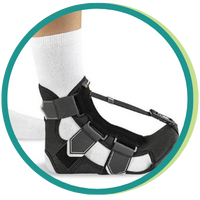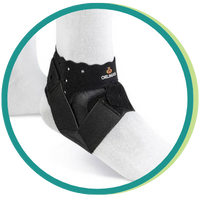
Plantar Fasciitis: Causes, Symptoms, and Treatment
Plantar fasciitis is one of the most common causes of foot pain, affecting thousands of people worldwide. This condition occurs due to inflammation of the plantar fascia, a connective tissue that connects the heel to the toes and absorbs impact while walking. The pain, typically concentrated in the heel area, can be intense upon waking up and taking the first steps of the day. Repetitive movements and continuous strain can worsen the condition, making the discomfort more severe over time. Additionally, lack of proper treatment can lead to complications, affecting mobility and making daily activities more difficult. In this article, we explore what plantar fasciitis is, its main symptoms, risk factors, treatment options, and preventive measures to avoid this debilitating condition.
What is Plantar Fasciitis?
Plantar fasciitis is an inflammation of the plantar fascia, often caused by excessive strain, improper footwear, or biomechanical factors. This condition is frequently diagnosed in runners, people who spend long hours standing, or those who wear unsuitable shoes. The pain is usually most intense in the morning and can worsen throughout the day if the person continues walking without proper support.
A common question is: What is plantar fasciitis and how can it be prevented? The answer lies in understanding the causes and adopting effective strategies to minimize the impact on the feet. Using appropriate insoles and performing daily stretches can help prevent the condition from worsening. Additionally, maintaining a healthy weight and choosing the right footwear are fundamental steps to avoid this painful inflammation.
Main Symptoms of Plantar Fasciitis
The most common symptoms include:
- Intense pain in the sole of the foot, especially in the heel.
- Tenderness when touching the affected area.
- Stiffness upon waking up or after long periods of rest.
- Difficulty walking barefoot or on hard surfaces.
- Swelling and inflammation in the plantar region.
If the pain persists for several weeks or limits daily activities, seeking medical advice is essential for an accurate diagnosis and an effective plantar fasciitis treatment. Without proper treatment, the condition may worsen, making recovery slower and more complex. In severe cases, pain may spread to other areas of the foot and even affect posture, causing discomfort in the ankle and knee joints. The earlier the treatment begins, the better the chances of a quick and effective recovery.
Risk Factors
Certain conditions and habits can increase the risk of developing plantar fasciitis:
- Wearing inappropriate footwear that lacks proper arch support.
- Engaging in high-impact activities such as running and jumping.
- Excess weight, which increases pressure on the plantar fascia.
- Flat feet or high arches, altering weight distribution.
- Aging, as plantar fascia elasticity decreases over time.
Lack of proper warm-up or stretching before physical activities can also contribute to the development of this condition. People who frequently walk or run on uneven terrain are more prone to plantar fasciitis. Additionally, standing for prolonged periods, as required in some professions, can overload the plantar region and cause intense pain by the end of the day.
Plantar Fasciitis Treatment
There are various approaches to treating plantar fasciitis, ranging from home remedies to specialized therapies. The main treatment options include:
Use of Orthopedic Insoles: Insoles are essential to provide support and relieve pressure on the plantar fascia.
Night Splint for Plantar Fasciitis Fastitech® Ref. FP02: Designed to provide relief and comfort overnight, this splint properly immobilizes the ankle and foot, reducing pain and inflammation. It features Space 3D laminated fabric, a non-slip sole, and a customizable fit with six straps and buckle adjusters.
Day Splint for Plantar Fasciitis Fastitech® Ref. FP01: Ideal for daily treatment, this orthotic provides continuous relief while moving. It includes an anatomical silicone pad for plantar fascia massage, four adjustable elastic bands, and bilateral use, offering effective support for both feet.
Exercise Kit for Plantar Fasciitis Fastitech®: Includes a foam roller and an elastic band for myofascial release exercises and plantar fascia stretching. The roller can be used for massage and cryotherapy, helping to reduce inflammation and pain. The elastic band assists in plantar fascia dorsiflexion and muscle relaxation in the leg and thigh.
Heat and Cold Therapy: Applying ice to the affected area helps reduce inflammation, while heat therapy can relax muscles and improve blood circulation. Alternating between hot and cold applications can accelerate recovery.
Stretching Exercises: Stretching exercises for the calf and plantar fascia are essential to reduce tension. Performing these exercises daily helps maintain flexibility and prevent future pain episodes.
Therapeutic Massage: Massage can help relieve pain and relax foot muscles. Using specific massage rollers for the feet can be an effective complement to symptom relief.
Plantar Fasciitis Cream: Anti-inflammatory creams can help reduce pain and improve daily comfort. These creams should be applied with circular massages to enhance their effects.
How to Treat Plantar Fasciitis Naturally?
Natural treatment for plantar fasciitis can be highly effective in relieving pain and reducing inflammation without resorting to medication or invasive procedures. One of the most recommended strategies is performing daily stretches for the calf and plantar fascia, which helps maintain flexibility and prevent morning stiffness. Additionally, massaging the affected area with a tennis ball or massage rollers can stimulate blood circulation and relieve tension in the plantar region. Applying alternating hot and cold compresses also aids recovery, as cold reduces inflammation while heat improves circulation.
Another effective approach is choosing appropriate footwear with good cushioning and arch support to prevent the condition from worsening. Reducing impact during walking and physical activities by opting for low-impact exercises like swimming or cycling can also be crucial for recovery. Moreover, some people find relief with essential oils and natural anti-inflammatory creams, which can be applied directly to the affected area. By adopting these measures, it is possible to alleviate symptoms and prevent the condition from progressing, ensuring comfort and a better quality of life.
When to Seek Medical Help?
If symptoms persist for more than six weeks, progressively worsen, or significantly limit daily activities, consulting an orthopedist or physical therapist is advisable. The specialist may recommend imaging tests such as X-rays or MRIs to assess inflammation severity and suggest appropriate treatments. In many cases, plantar fasciitis treatment may include physiotherapy and muscle strengthening to prevent recurrence. Professional follow-up is crucial to ensure a proper recovery plan and avoid chronic conditions.
Conclusion
Plantar fasciitis is a painful condition that can significantly affect quality of life, but fortunately, there are many effective treatment options. Using orthopedic insoles, applying heat and cold therapy, and adopting natural remedies can help relieve symptoms and prevent future complications. If pain persists, seeking medical assistance is essential for proper recovery. Additionally, maintaining healthy habits, such as wearing suitable footwear and practicing regular exercises, is key to preventing plantar fasciitis from recurring.
To find the best solutions for plantar fasciitis treatment, visit Loja Ortopédica.







No Comments